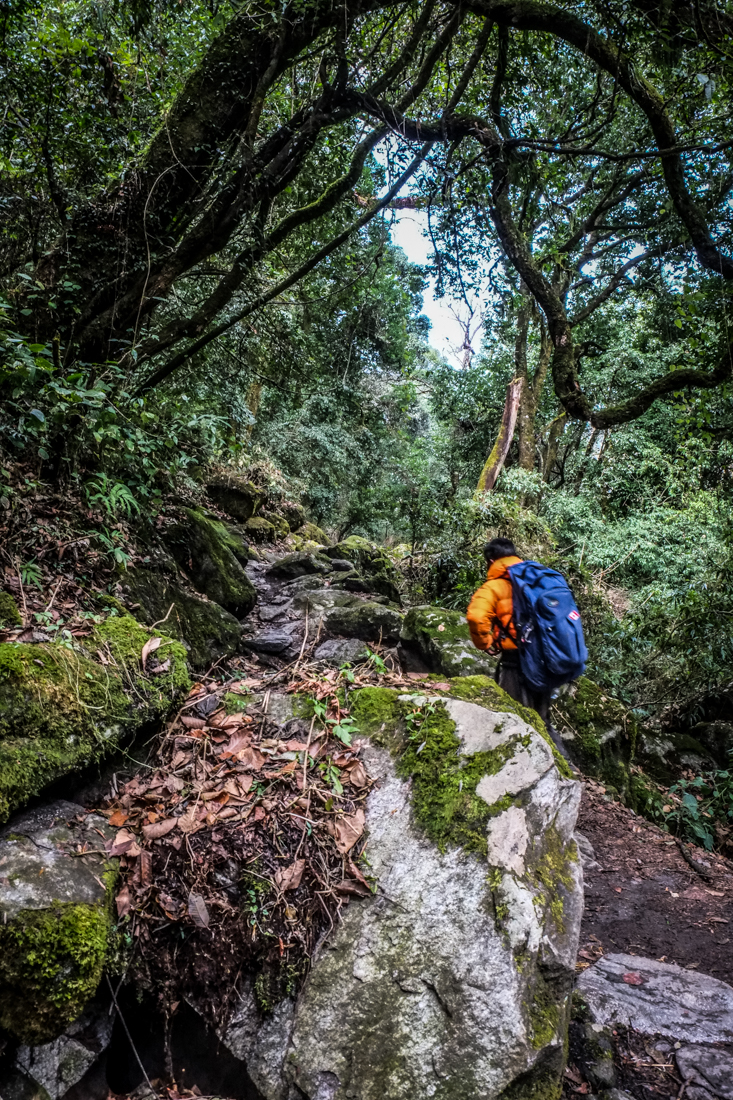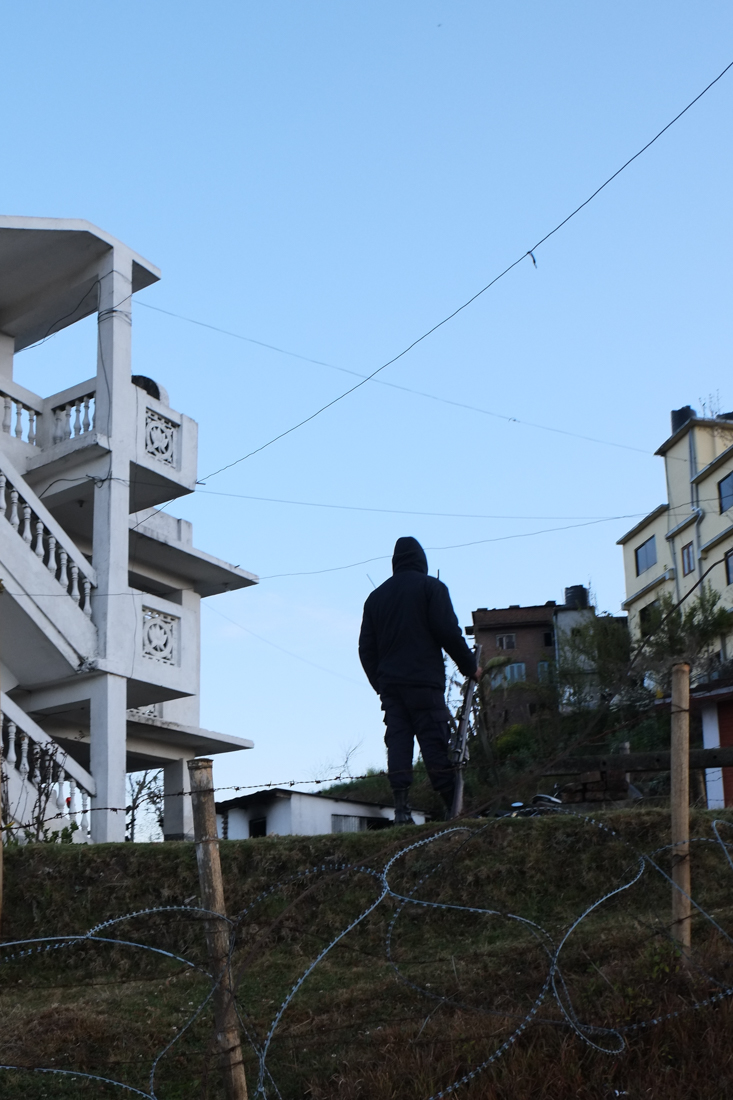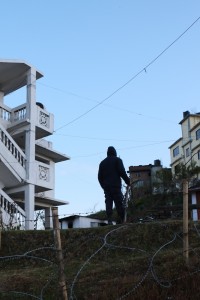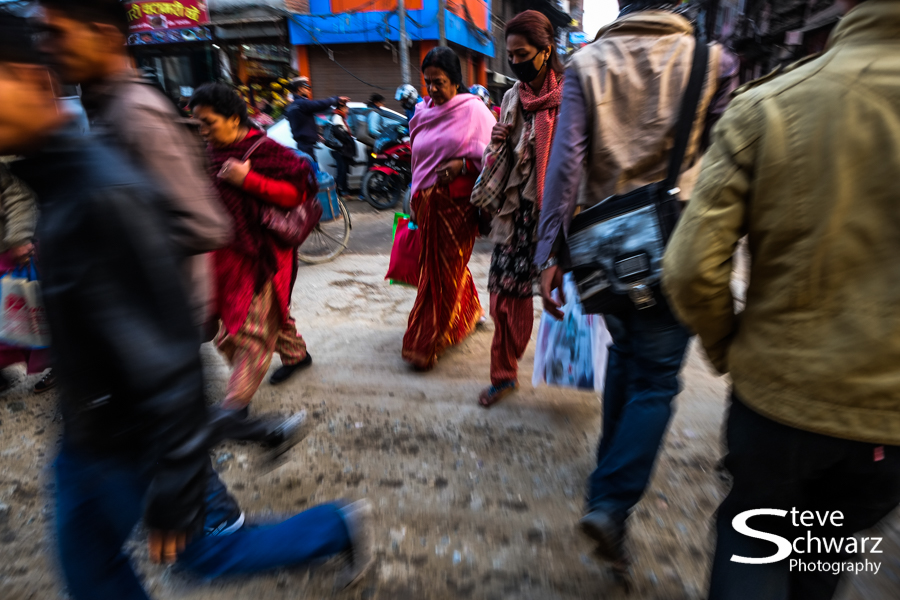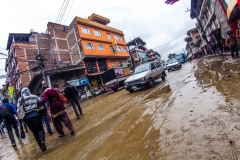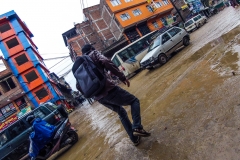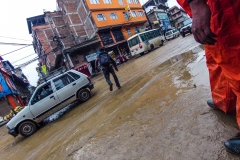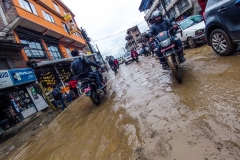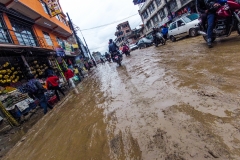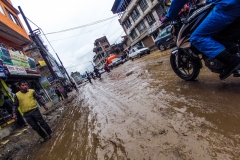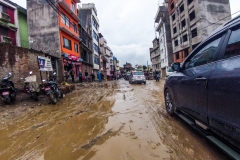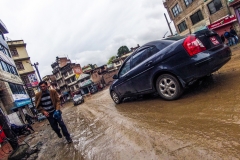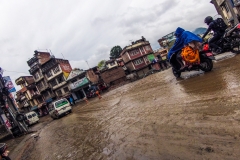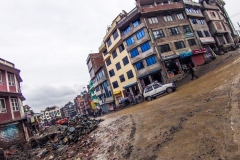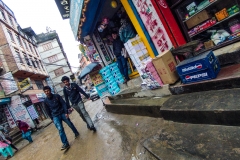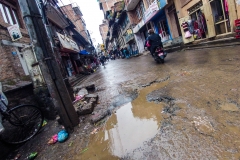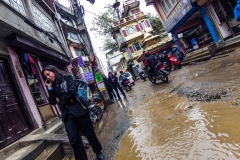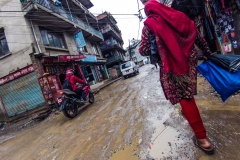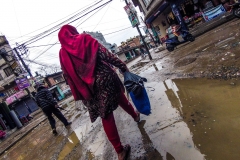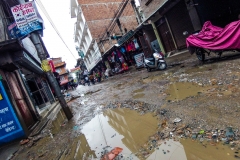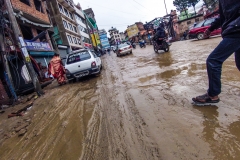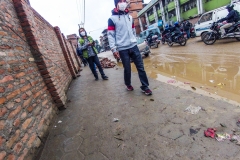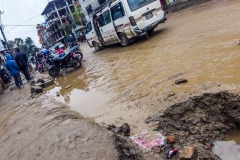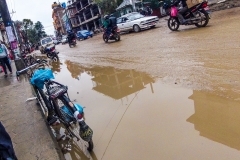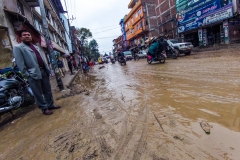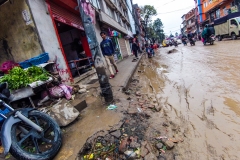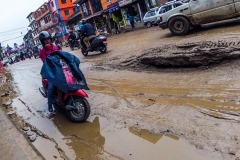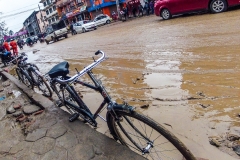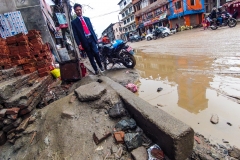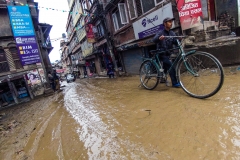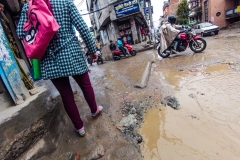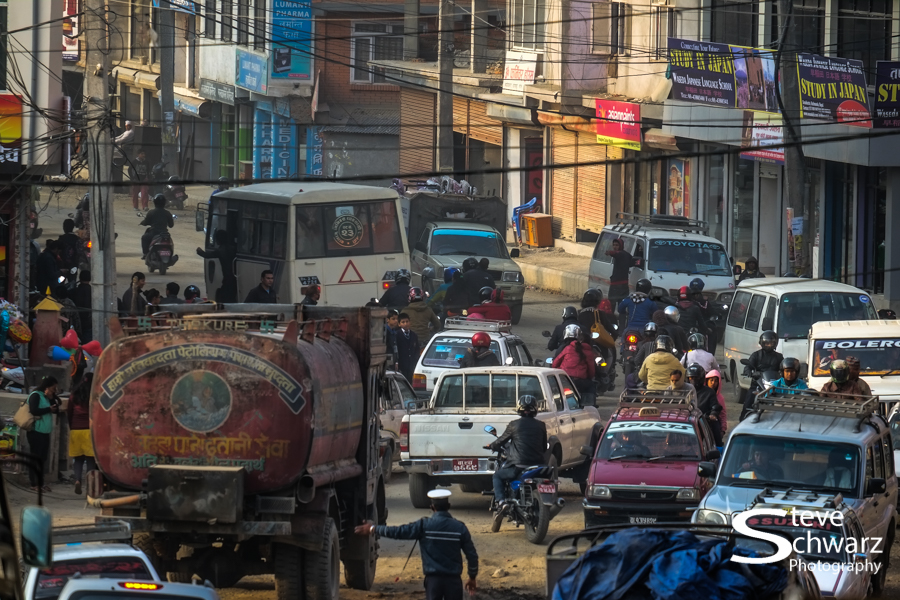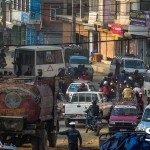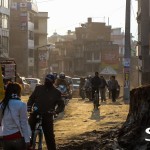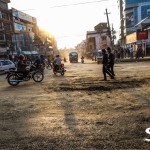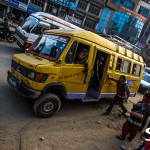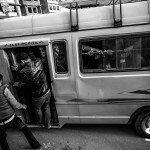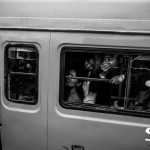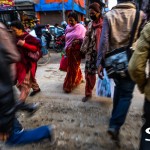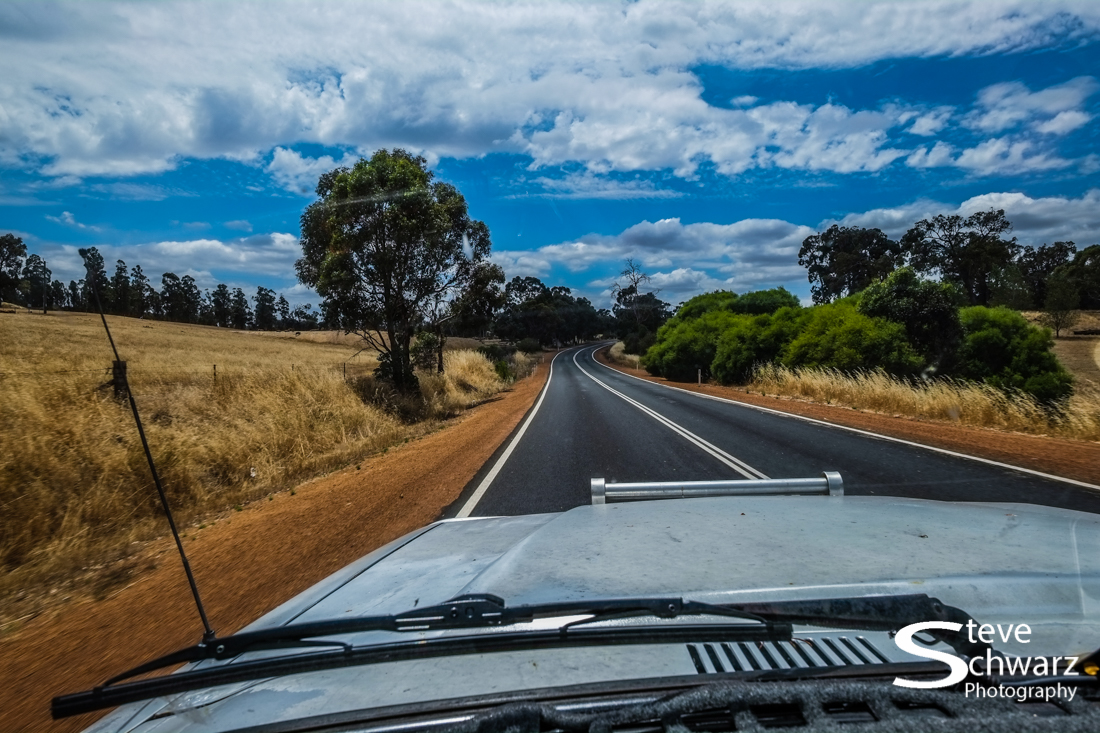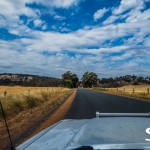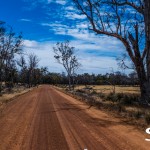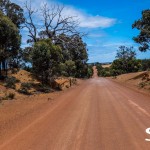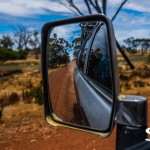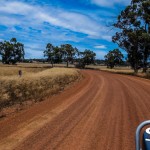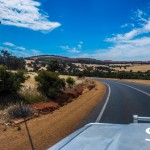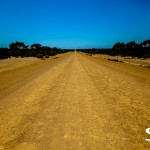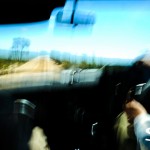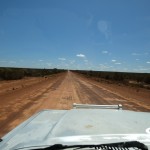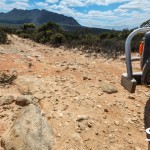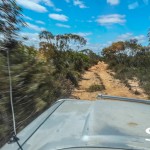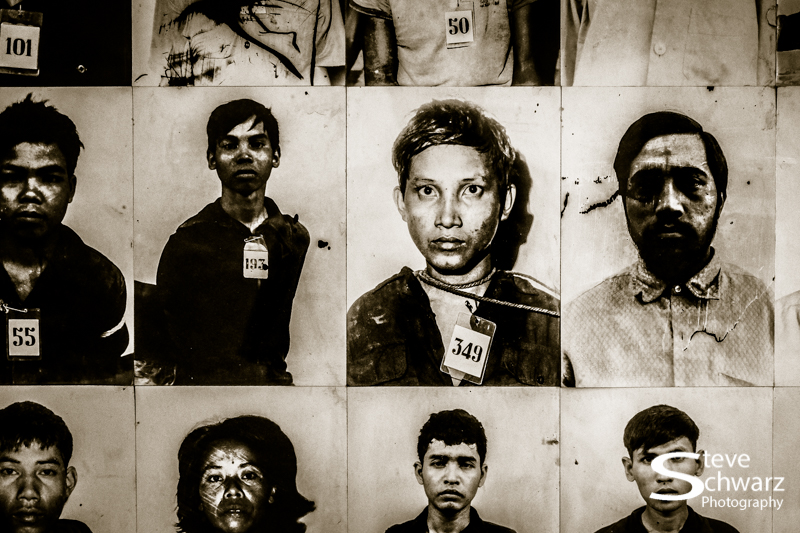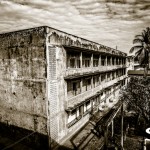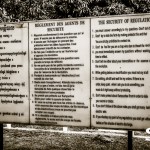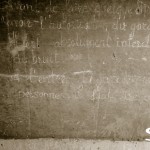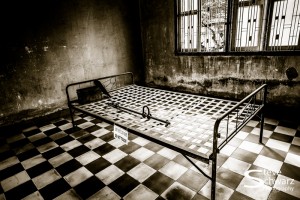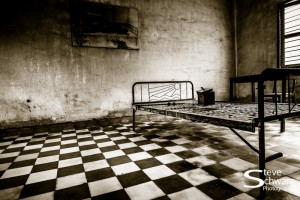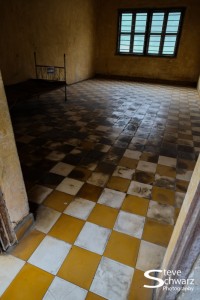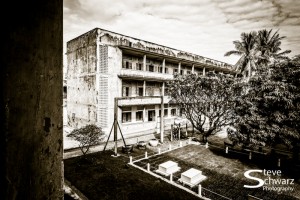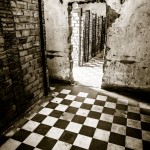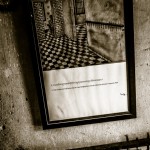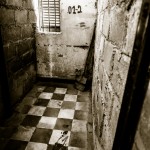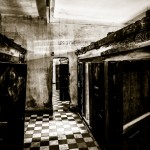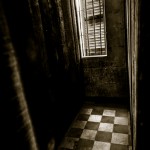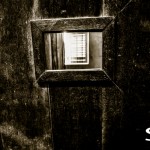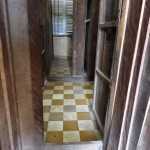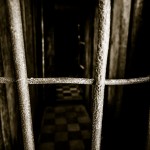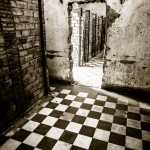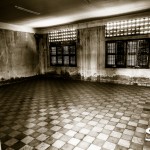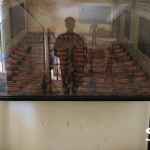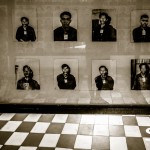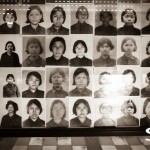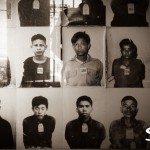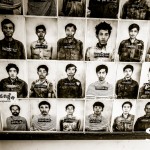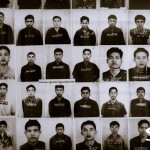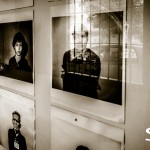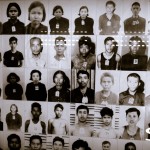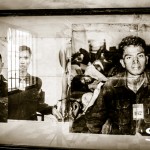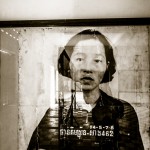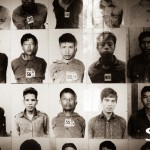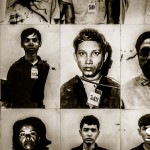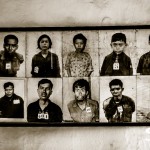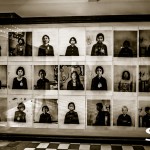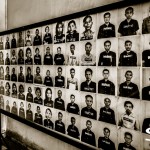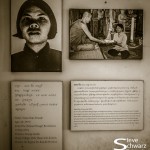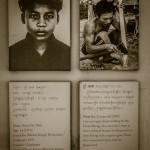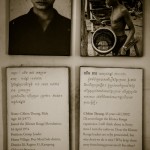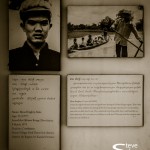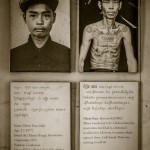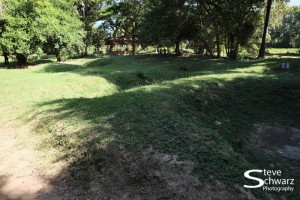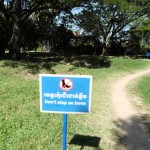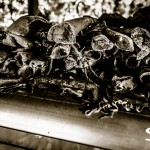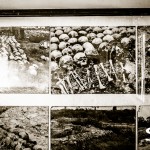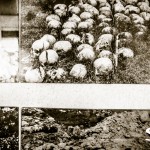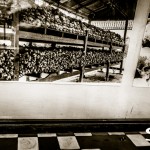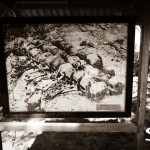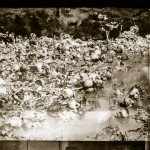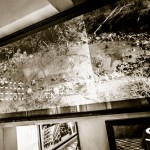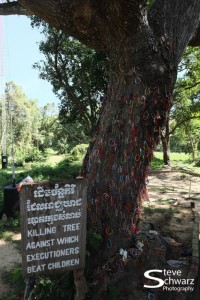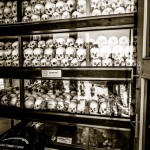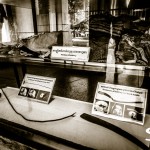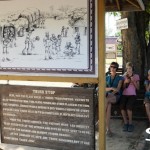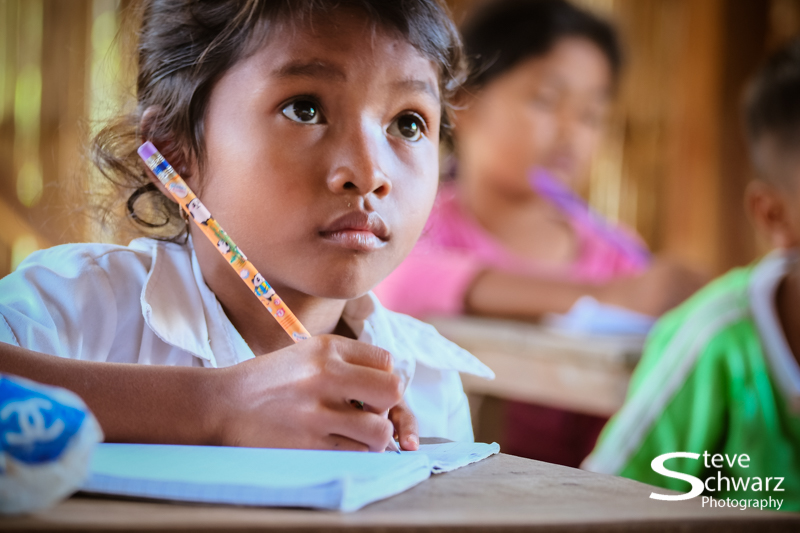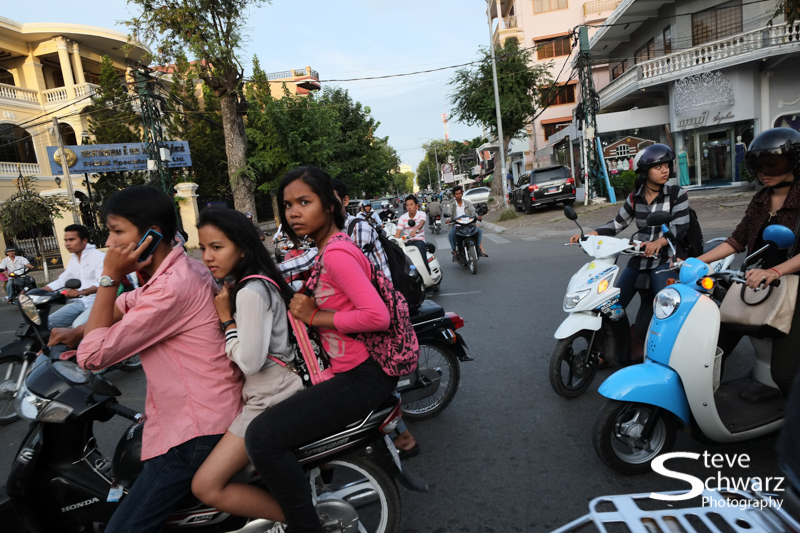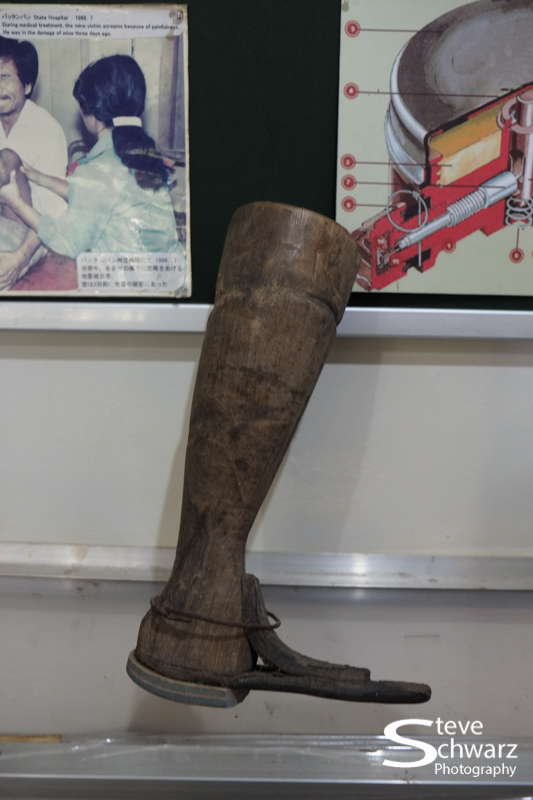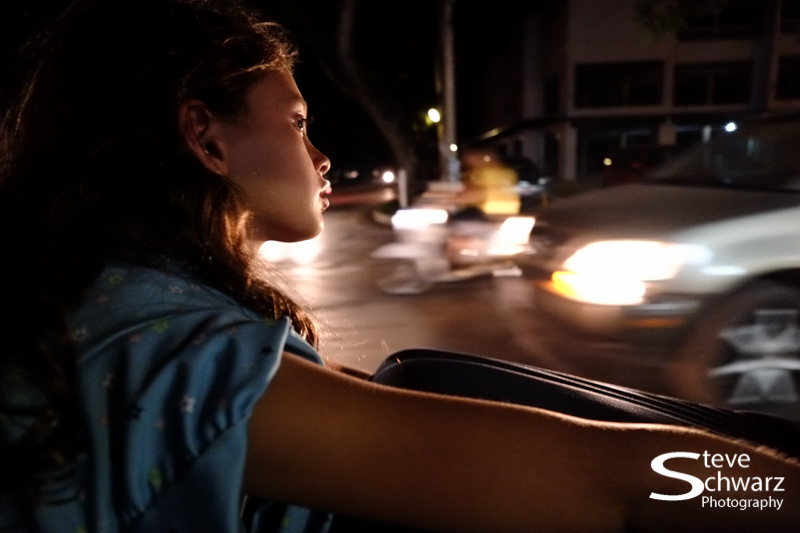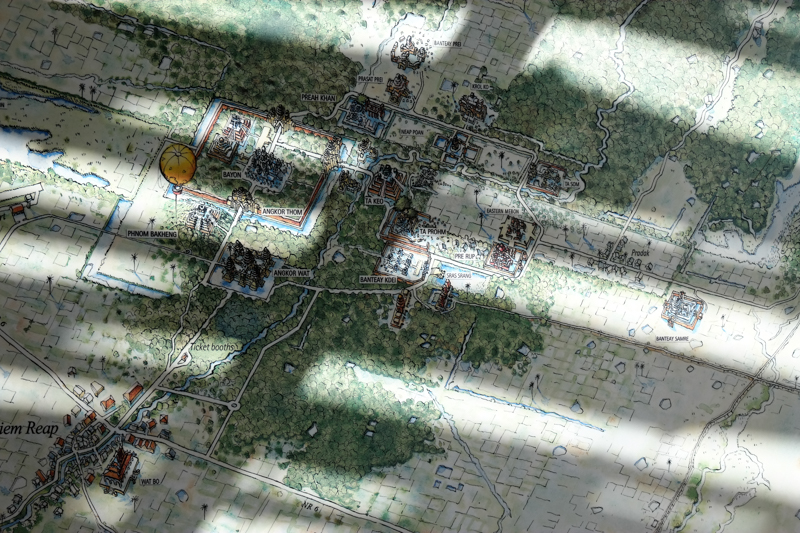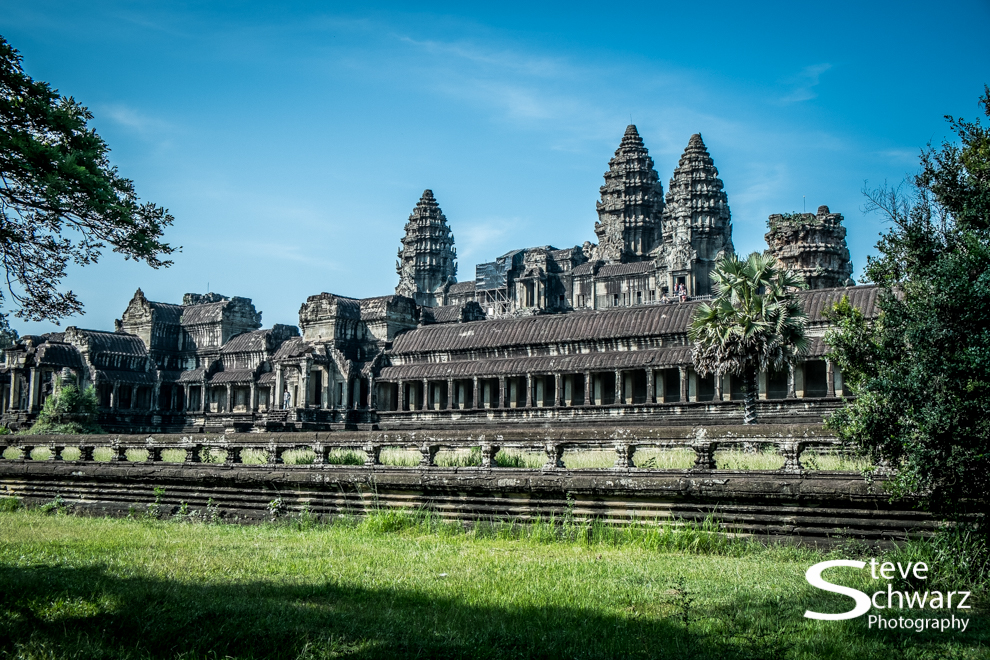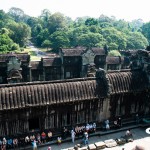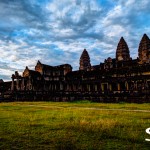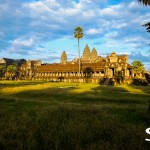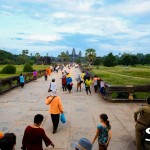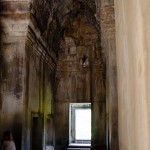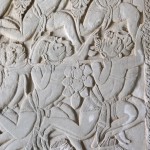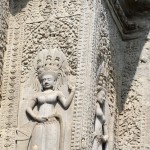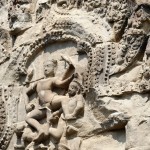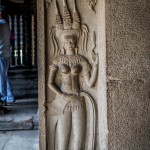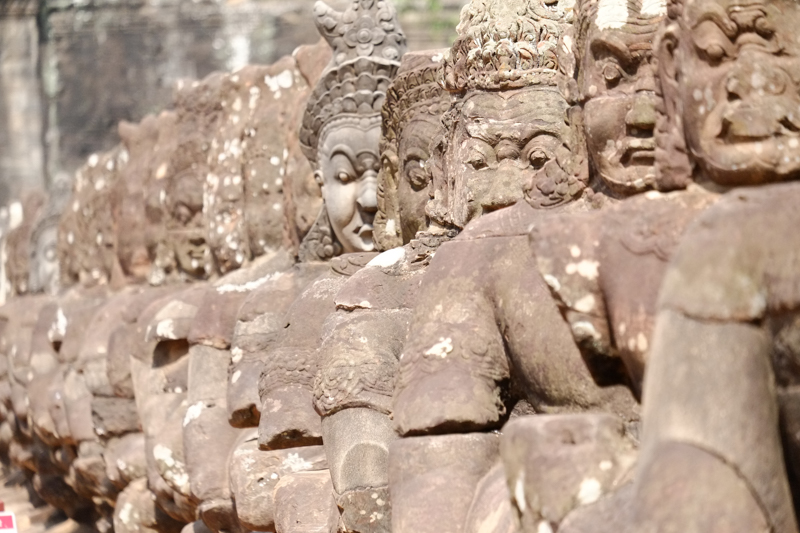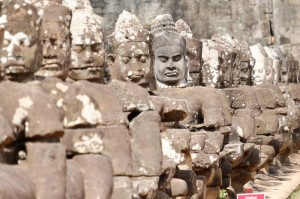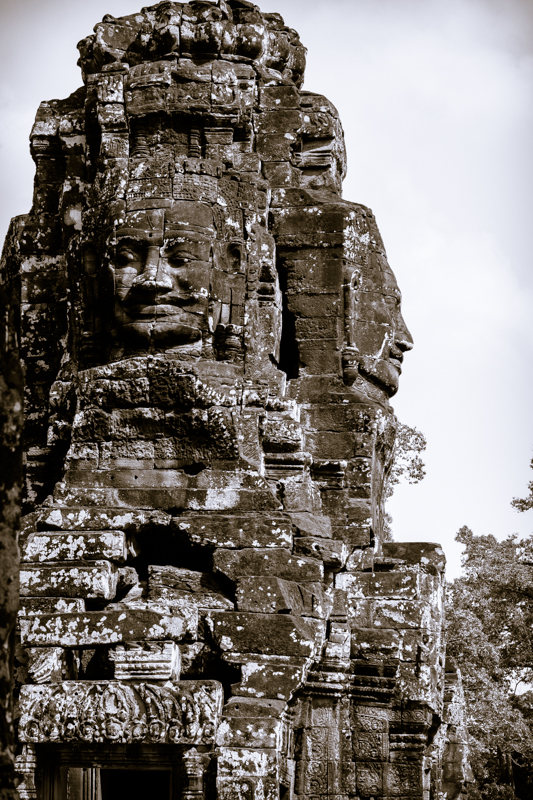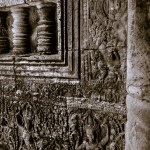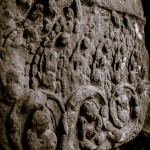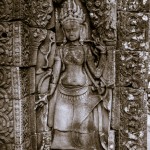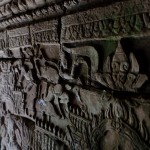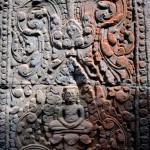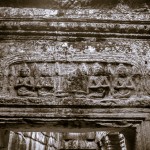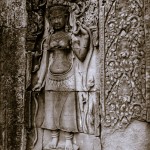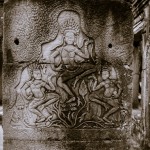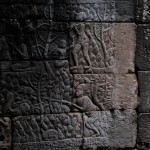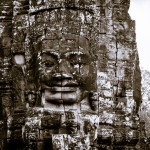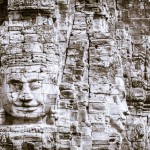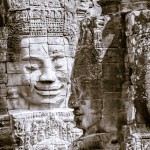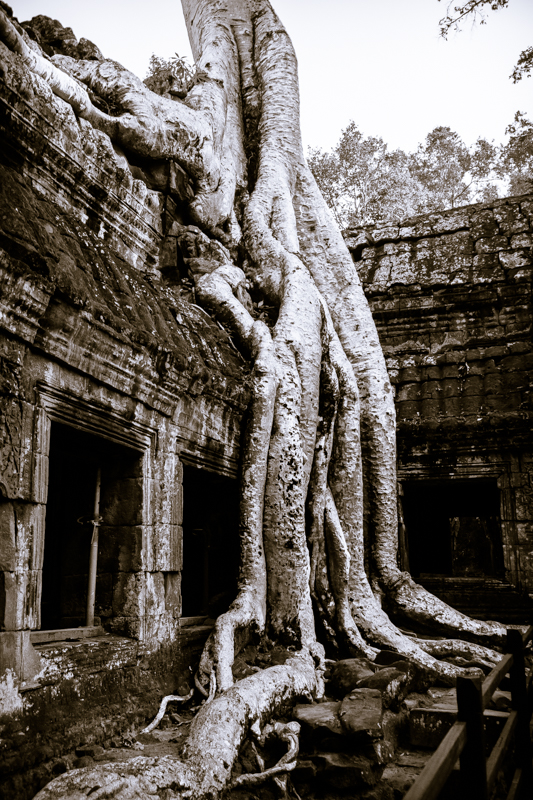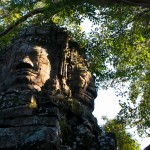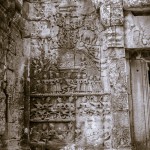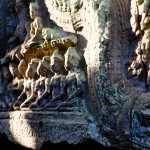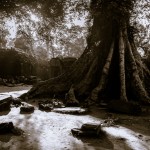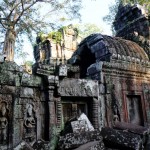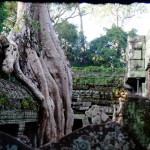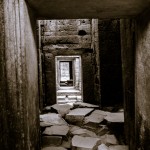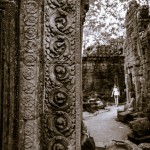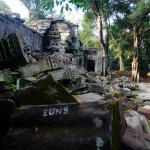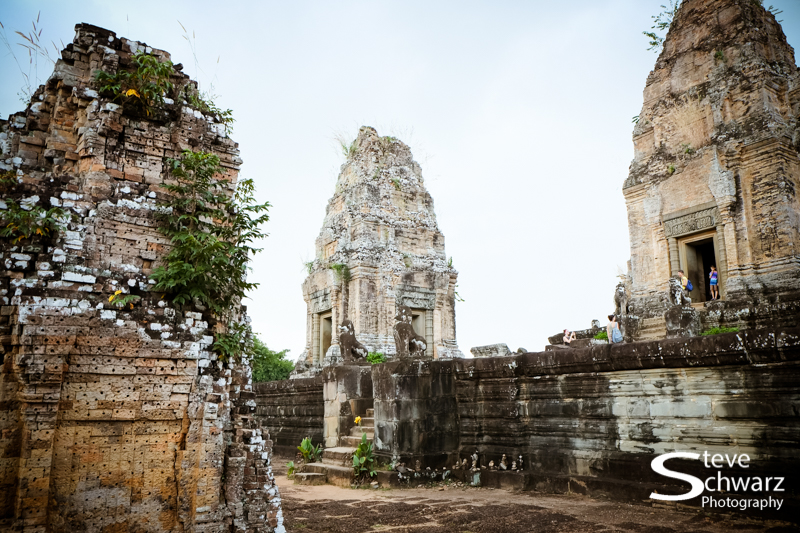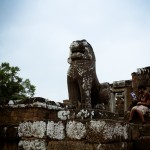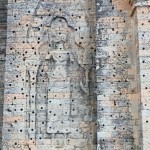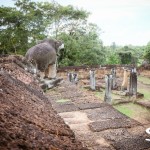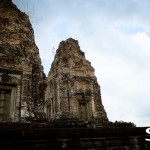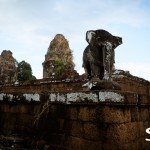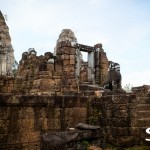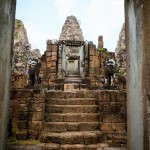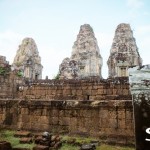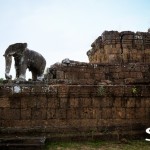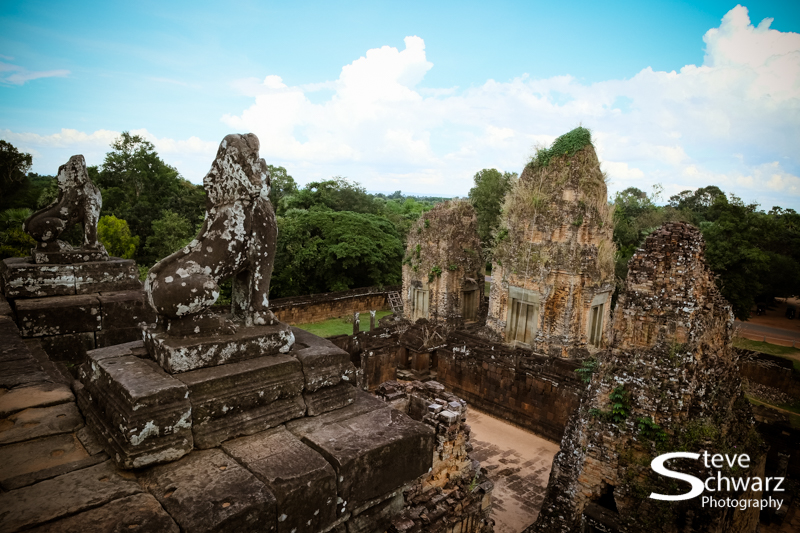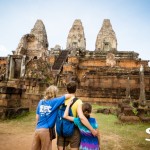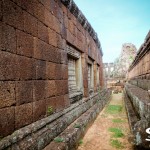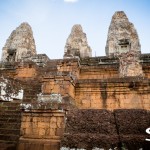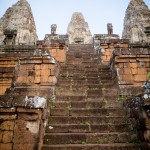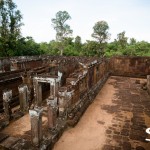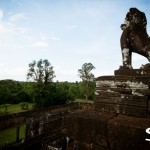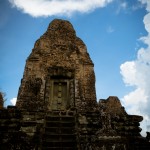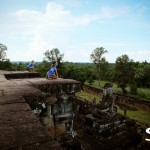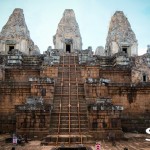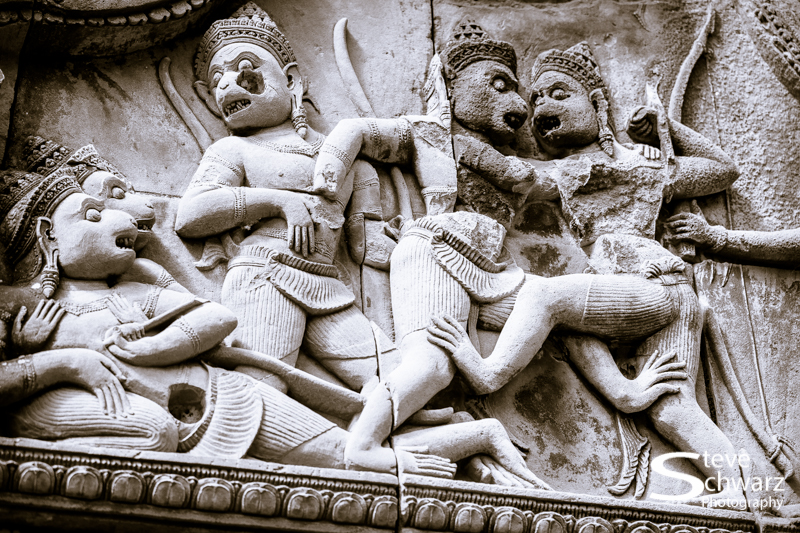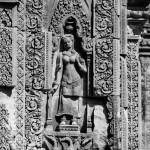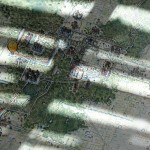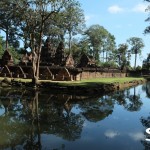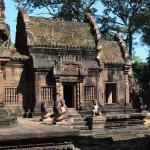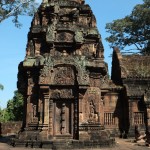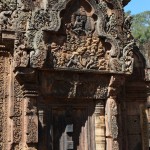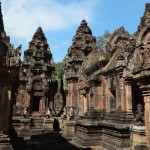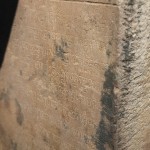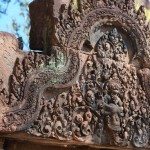Cambodia – a land of stunning natural beauty, and a Terrible past. After nearly three weeks of touring Cambodia, including stops at the 12th century temples in Angkor (Siem Reip) and two weeks teaching english in a small rural school. Our last destination was the capital city of Phnom Penh, and out last sight seeing excursions were to the former prison Tuol Sleng and the Choeung Ek killing fields. In retrospect, we should have done it the other way around; seen the terrible side of Cambodia, then refresh our memories with the friendly children at the school. The way we did it, I was left with a terribly puzzled as to why Cambodia’s recent history included so much bloodshed, so much pain and there are still so many lingering effects.
So where do I start ?. To be able to grasp this mystery, we have to go back to history.
Calm before War
The recent history of Cambodia is intricately linked to competing Cold War loyalties in neighbouring Laos and Vietnam. Until the mid 1950’s Cambodia, Laos and Vietnam were all part of the French Colonial empire. Cambodia and Laos became independent peacefully. In Vietnam, the path for independence was decided by the Geneva Accords of 1954, that ended the First Indochina War (1946 – 1954) with the French, and divided Vietnam at the 17th parallel [1]. Trouble for Cambodia and Laos started during the Second Indochina War (1955-1975), more commonly known as the Vietnam War, fought between North Vietnam and South Vietnam. Both sides were supported by Cold War adversaries: Soviet Union, China and other communist nations supporting communist North Vietnam, and United States and other anti-communist allies supporting pro-Western South Vietnam [1]. Other combatants in the Vietnam war were the Viet Cong (also known as the National Liberation Front, or NLF), a Vietnamese communist group that was aided by North Vietnam and China [1]. The Viet Cong were based in south Vietnam and fought against the South Vietnamese army. Cambodia had its own communist group that was aided by North Vietnam and China, known as the Khmer Rouge, that fought against the pro-western government forces in Cambodia [1]. The Vietnam war would soon pour over into Cambodia.
Era of the Vietnam War
As the Vietnam war progressed, both Laos and Cambodia became involved [2, 3]. Initially Cambodia was neutral, allowing both the North Vietnamese, and Viet Cong to transport weapons, soldiers and supplies along the Ho Chi Min Trail in eastern Cambodia and a location for military bases to attack South Vietnam [3, 4]. Cambodia also allowed the US to stage Special Forces reconnaissance missions to the Ho Chi Minh and secretly and bomb Viet Cong hideouts in Cambodia [5,6,7]. A military coup in Cambodia added a US-backed Cambodian general, and opened the door for expanded US involvement – both on the ground by US troops and an escalation of the carpet-bombing raids by massive B-52 bombers to destroy suspected North Vietnamese supply lines and Viet Cong hideouts in eastern Cambodia and all along the Cambodian border with South Vietnam [4,8,9,10]. The amount of bombs dropped on Cambodia during the war exceeded the amount dropped on Europe during World War II [8]. The bombing was considered illegal under US law, because it was unauthorized by Congress. In 1969 the US government officially announced that bombing in Cambodia would start. However, based on US Airforce computer data released in 2000, the scale and magnitude of bombing missions escalated in 1969, and not that bombing had actually started in 1964 [8]. The escalation in 1969 included carpet-bombing by massive B-52 bombers, dropping high explosive 250lb bombs, napalm and dart cluster-bombs in their effort to destroy suspected North Vietnamese supply lines and Viet Cong hideouts in eastern Cambodia and all along the Cambodian border with South Vietnam [8].
The Khmer Rouge started as a small communist insurgency against Prince Norodom Sihanouk’s neutralist Government, and its rise of power was driven by resentment caused the large number of civilian casualties caused by the indiscriminate and secret carpet bombing raids of eastern Cambodia by the United States (1969-1973) and the overthrow of Prince Sihanouk by a pro-American general in March 1970 leading to thousands of new recruits joining the Khmer Rouge [10]. When the deposed Prince embraced the Khmer Rouge, many loyal Cambodians followed [11,12]. Supported by the North Vietnamese Army, and given training, and weapons from China and North Vietnam the Khmer Rouge continued to defeat the US backed Cambodian army. In 1975, the communist forces in Cambodia (Khmer Rouge), Laos (Pathet Lao) and North Vietnam had defeated the anti-communist forces lead to peace and re-unified Vietnam [1,2,3].
3 years, 8 months and 20 days-long era of Khmer Rouge
By this time, Cambodia had endued five years of foreign interventions, bombardment, and civil war and now the reign of Pol Pot and the Khmer Rouge – and one of the most deadly genocides in human history was just starting. The Khmer Rouge under the leadership of Pol Pot implemented their radical Maoist and Marxist-Leninist restructuring of the society; its goal was to transform Cambodia into a peasant-dominated agriculture cooperative [13]. Schools, mosques, churches, and government buildings were closed or turned into prisons, re-education camps or granaries. Money and personal property was deemed worthless. Religious practices, and traditional Khmer culture were banned.
All political and civil rights were abolished. Books were burned; cars and any form of private or public transportation was banned; communication infrastructure like television, radio and telephone wires were all dismantled. The country was cut off from the outside world. Under threat of death, everyone including the sick, elderly and infirm were forced to leave the towns and cities, and march into the countryside. Children were placed in “re-education” camps while adults were forced to work as slaves for 12 to 15 hours a day, without adequate food, rest or medical care. They had to grow rice – though not for them, the food was taken away and traded to China for weapons [13,14,15,16]. Anyone with a connection to the defeated pro-US government (civil servants, politicians, soldiers, military officers), anyone with an education or training (doctors, academics , school teachers, lawyers, engineers, scientists and professionals in any field, journalists, artists, students, even musicians and mechanics, electricians), anyone deemed pro-American, pro-Western, pro-capitalist, religious groups (Buddhist monks, and those with muslim or christian beliefs), those belonging to minority groups such as the, ethnic Chinese, Vietnamese and Thai, and also Cambodians with Chinese, Vietnamese or Thai ancestry [13,14,15,16]. Even those knowing a foreign language, wearing glasses or foreign clothing styles was enough to be taken away, along with their extended families, to be executed and their bodies disposed of in mass graves in what are now called “the killing fields” [10,13,14,15,16]. Others were taken to prisons, to be interrogated and tortured to obtain names of other people whom are considered a potential enemy to the regime, sign a ‘confession’ and then taken to be killed.
Being a member of the Khmer Rouge did not guarantee safety. In the eyes of Pol Pot, the Khmer Rouge contained a series of factions that needed to be ‘cleansed’ [10,13,14,15,16]. The Khmer Rouge soldiers trained by the Vietnamese were imprisoned, interrogated and executed during the purges of its own ranks. During the three years, eight months and 20 days of Khmer Rouge rule it is estimated that between 1.2 and 2.2 million Cambodians died either at the hands of Pol Pot’s murder squads, or from starvation and disease. Almost every Cambodian alive lost a family member under the Khmer Rouge, in one of the most brutal and genocidal regimes in modern history [9,10,13,14].
Invasion and occupation by Vietnam
During the Vietnam War the North Vietnamese and Khmer Rouge communists had worked together to fight the U.S.-backed regime. After taking power, the Khmer Rouge leadership began to loose trust in the Vietnamese communists and instigated border raids on Vietnam [1]. In December 1978 Vietnam retaliated by invading and removing the Khmer Rouge-dominated regime, and forcing Pol Pot and the Khmer Rouge forces to flee to the border region with Thailand. On 7 January 1979, the Vietnamese army, captured Phnom Penh and ended the 3 years, 8 months and 20 days-long genocidal regime of the Khmer Rouge [9,13,14,15]. Suddenly, the Khmer Rouge’s unspeakable atrocities were revealed and had generated an outcry echoed throughout the world [15,16,17]. As news of mass starvation, torture, and killings from Cambodian refugees reached international headlines, Cold War rivalry at the United Nations in New York, continued to dictate political and diplomatic decisions. United States, Britain and other European nations, China and pro-Western Asian countries, while denouncing the Khmer Rouge crimes, voted to award Cambodia’s contested seat in the United Nations to the Coalition Government of Democratic Kampuchea which was controlled by the Khmer Rouge, instead of have it go to a communist government controlled by Vietnam and its mentor, the Soviet Union [10, 17]. Simply, Vietnam was on the wrong side of the cold war [18]. Opposing this UN decision to maintain Khmer Rouge representation were the Soviet bloc and its allies, including a number of non-aligned countries, notably India , but were easily outvoted in the General Assembly [11, 18]. Thus the international organization that adopted the Universal Declaration of Human Rights (“the international community vowed never again to allow atrocities like those of that conflict happen again.”), the Genocide Convention (“Persons committing genocide or any of the other acts enumerated in Article 3 shall be punished, whether they are constitutionally responsible rulers, public officials or private individuals.”), and the Convention on Torture, chose to prioritize politics over the genocide of millions. In turn, the war-torn country of Kampuchea was denied international aid and trade. The Khmer Rouge continued to have a seat in the United Nations General Assembly for 11 years, and no one seemed to be in any hurry to bring the leaders of the Khmer Rouge regime to trial [18, 19]. Understandably, Survivors of the Khmer Rouge regime were appalled.
Throughout the 1980’s and 1990’s the Khmer Rouge forces were secretly receiving training, weapons, battle plans, uniforms, money and satellite intelligence from the US, UK, Thailand and China because of their united hostility to communist Vietnam [17, 20, 21]. Only in 1989, did the British finally admit that they had secretly provided training the “resistance” for more than four years in land mine–laying techniques, on the use of improvised explosive devices, booby traps and the manufacture and use of time-delay devices [17, 21]. The Khmer Rouge continued to attack government-controlled garrison towns, planted thousands of mines in rural areas, attacked road transport, blew up bridges, kidnapped village chiefs and targeted civilians. Hundreds of thousands become refugees, and joined UN-supported refugee camps along the Thai border, although these were controlled by the Khmer Rouge [17]. To defend themselves from repeated attacks from the Khmer Rouge, the Vietnamese laid the world’s longest minefield, stretching from the Gulf of Thailand to the Lao border, and then in 1989, Vietnam withdrew its occupying army from Cambodia [1,3].
Enter the UN – UNTAC
In 1992, a United Nations peacekeeping force arrived in Cambodia, part of the United Nations Transitional Authority in Cambodia (UNTAC) to ‘restore and maintain peace’ and to supervise the country until a Cambodian government was elected. As part of the UNTAC brokered peace process, all of the genocidal actions of the Khmer Rouge were ‘forgotten’, by UN officials and the Khmer Rouge were welcomed back from their jungle hideouts to join the peace process [11, 17, 47]. The UNTAC mandate also included a disarmament program; while other militia groups surrendered their weapons and military supplies, the Khmer Rouge refused to disarm, refused to allow UNTAC enter its territory and even attacked and captured UNTAC personnel [46, 47]. Based on voter turnout, the UNTAC mission was considered a success [46], it did not lead to a disarmed Khmer Rouge, did not enforce the election results, and by the time that UNTAC left Cambodia, the Khmer Rouge had more weapons and occupied more territories than when UNTAC arrived [46].
A New Beginning ?
In 1993, big changes were coming to Cambodia. Peace has returned, the monarchy is restored, the country is re-named to the Kingdom of Cambodia, Buddhism is re-established as the state religion, the newly formed Cambodian Government officially outlaws the Khmer Rouge [22], and the Khmer Rouge loose their seat in the UN General Assembly.
The beginning of the end of the Khmer Rouge regime began with kidnapping and murder tourists [23], followed by a Cambodian Government declared an amnesty law. Thousands of Khmer Rouge soldiers surrendered, others defected and joined the Cambodian Army to battle their former colleagues (including those implicated in the murder of the tourists in 1994 [23]. The Khmer Rouge regime continued to exist until 1998, by which time, all of its leaders had defected to the Royal Government of Cambodia, been arrested, or had died. Initially supported by Cold War alliances and Communist China, the demise of the Pot Pot Khmer Rouge regime was accomplished by Cambodians [11, 12].
From one Dictator to Another
Politically, since 1979 Cambodia has been dominated by one person – Hun Sen. Hun Sen, a former mid-level Khmer Rouge leader defected from the movement to Vietnam in 1977 and is currently serving in his fifth term as Prime Minister [25].
In 1979 when the Vietnamese invaded Cambodia, he was appointed Prime Minister and Foreign Minister of the Vietnamese-installed government. He remained in the government throughout the Vietnamese occupation during the 1980s.[58]. In 1993 during the UN supervised general elections, Hun Sen and the Cambodian People’s Party (CPP), which represented the previous communist government, had lost the election. However, not willing to play gracefully (or fair), he and the other CPP government ministers refused to accept defeat, throwing the country into political crisis. A UN brokered ‘compromise’ left Cambodia with a three-party coalition government and two co-Prime Ministers. In 1997 Hun Sen used his influence and control of the Army in a coup d’etat, ordering the arrest and execution of political opponents in the coalition government with a clear objective of achieving sole control of the country [24, 26, 27]. After the 2013 general election (not surprisingly Hun Sen and the Cambodian Peoples Party (CPP) won the election, opposition parties and EU monitors reported widespread election irregularities followed by six months of political deadlock, demonstrations and mass protests [28, 29, 30, 32], and opposition groups asked the United Nations to investigate [32, 35].
The former Khmer Rouge commander has a reputation as a ‘wily operator who destroys his political opponents’ [25, 36], Hun Sen is widely viewed as a dictator that has assumed authoritarian power in Cambodia using ‘brute military strength’ [3,25], corruption and ‘web of patronage’ to maintain his power base [37, 38, 39]. Protests in support of higher wages, land rights or greater political freedom are brutally dealt by deploying the Army or riot police [35, 40, 41]. During the mid 1990s remnant factions of the Khmer Rouge were still waging sporadic attacks on government forces [58]. Hun Sen wanted to bring peace to Cambodia, and be seen as a political hero by ending the long standing conflict with the Khmer Rouge [58]. In 1996, the Cambodian Government offered an Amnesty to Khmer Rouge, and senior-level employment opportunities in the government and military [58]. Hun Sen and the CPP are synonymous with corruption. Transparency International ranked Cambodia at 160th out of 175 countries, and Global Witness 2009 report that Hun Sen’s government is accused of carrying out secret negotiations with interested private parties, taking money from those who he would then grant rights to exploit the country’s resources [42]. During his tenure, Hun Sen’s government has sold 45% Cambodia’s total landmass to foreign investors, including wildlife protected areas, national parks, and causing forced eviction of more than 150,000 Cambodians [43]. According to G. Evans, “There are stories, unverifiable but plausible, that 20 or more of Hun Sen’s closest associates have each amassed more than $1 billion through misappropriation of state assets, illegal economic activity, and favouritism in state procurement and contracting” [40]. There has also been political patronage bordering on parody, with one recent count putting the government’s size at 244 ministers and secretaries of state [40]. Hun Sen’s immediate family and senior members of the CPP government also have absolute control over all television and radio stations in Cambodia [44, 45]. In every town and rural village there are offices of the CPP, large billboards with pictures of the party leadership, and many house owners woke up to signs attached to their houses supporting the CPP. Whether or not everyone (or anyone) actually supports Hun Sen and the CPP, one thing is clear: today he is the richest man, and most likely, the most hated man in Cambodia.
What happened to the Khmer Rouge ?.
A quick internet search on the history of the Khmer Rouge comes up with a couple of heading lines:
“Cambodian Khmer Rouge trial of Comrade Duch set to end”[51]
“Verdict due in Comrade Duch Khmer Rouge trial”[49]
“Khmer Rouge Figure Is Found Guilty of War Crimes”….“A United Nations-backed tribunal on Monday found a 67-year-old former prison warden (Kaing Guek Eav, commonly known as ‘Duch’) of the Khmer Rouge guilty of crimes against humanity and war crimes for overseeing the torture and killing of more than 17,000 prisoners [50].
This was in 2009, and Kaing Guek Eav was the first major figure to be tried in the murderous Khmer Rouge regime since it was taken out of power in 1979 !. These headlines and the articles intrigued me to do more research on the recent history of Cambodia and the legacy of the Khmer Rouge. I had been to Cambodia, toured large parts of the country and had visited Toul Sleng Prison Museum (S-21) and the Killing Fields in Choeung Ek 158 one of 159 prisons and 309 killing fields set up by the KR between 1975 and 1979. As it turns out, Kaing Guek Eav was ‘discovered’ by a journalist [48]. Why had the government not found him and put him on trial ?
What happened, why did it take so long for justice to the victims of the Khmer Rouge regime ?
The reason that an internationally-supported tribunal for the crimes of the Khmer Rouge was not established until nearly thirty years after these crimes were committed, was largely the result of Cold War geo-politics.
In January 1979, the Vietnamese installed a new, a pro-Vietnamese government in the country now known as the People’s Republic of Kampuchea (PRK). Even though Vietnam had ended the murderous regime of the Khmer Rouge and set up a new government, the influence of the Cold War still ruled. Western nations, while denouncing the Khmer Rouge crimes were still slaves to Cold War mentality and decided it was better for the United Nations to continue to recognize the Khmer Rouge as the legitimate government of Kampuchea (Cambodia), instead of have it go to a communist government controlled by Vietnam and its mentor, the Soviet Union [8]). The Khmer Rouge continued to have a seat in the United Nations General Assembly from 1979 to 1990 [8], and continued to launch sporadic attacks on the new government and government military installations [11].
Between 1990 and the late 1990’s, the Cold War had ended, causing a shift in strategic allegiances, a change in military support, withdrawl of Vietnamese troops, a United Nations brokered peace plan, and eventually….Peace. With peace, came the opportunity to prosecute those that had been a part of the mass genocide during the Khmer rouge regime. With the legal system in tatters (most of the lawyers and judges were murdered during the Khmer Rouge regime), the co-Prime Ministers, wrote to the Secretary-General of the UN requesting UN assistance in prosecuting the crimes of the Khmer Rouge [51]. Negotiations between Cambodian Government and the United Nations on the actual format and mandate of the tribunal evolved into a “power struggle” [51] that continued for years. The UN wanted a ‘large’ number (10 – 15) of former Khmer Rouge to be prosecuted, whereas the Cambodian Prime Minister Hun Sen’s Government insisted on mechanisms to control and restrict the tribunal from determining who could be indicted and convicted and that the tribunal be limited to “senior Khmer Rouge members and those most responsible”, Hun Sen was adamant that the middle and lower rank officials in the Khmer Rouge would be reintegrated into Cambodian society, and not be prosecuted [52, 58]. As a one-time Khmer Rouge battalion commander, Hun Sen knows only too well that important members of the governing Cambodian People’s Party (CPP) have complicated ties to the former regime and that more investigations down the Khmer Rouge chain of command could expose their own shady pasts [58]. In the end, the UN compromised and ceded to Cambodia’s insistence on ownership of the trials” [11], a majority of Cambodian judges [52,54], and that the tribunal be limited to only “those most responsible” for the regime’s crimes” [52, 53, 58]. Finally, twenty-eight years after the Khmer Rouge was ousted from power, and following six years of intense negotiations between the United Nations and the Government of Cambodia the Khmer Rouge tribunal was established in 2007. The tribunal, a Cambodian court with UN-assistance with international prosecutors and judges, is officially known as the Extraordinary Chambers in the Courts of Cambodia (ECCC) [12, 52, 53].
United Nations Extraordinary Chambers in the Courts of Cambodia
After 72 days of hearing of evidence, 9 expert witnesses, 17 fact witnesses, 7 character witnesses and comments by 22 Civil Parties the first conviction by the ECCC, known as Case 001, was delivered on July 26, 2010 [56]. Kang Guek Eav, better known as Comrade Duch, a 67-year-old former prison warden at S-21 was convicted of war crimes for overseeing the torture and killing of more than 14,000 prisoners, crimes against humanity and grave breaches of the 1949 Geneva Conventions [56, 57]. He was sentenced to serve 19 years in prison — 35 years minus 16 years for time already served [56, 57]. “First came the verdict. Then the disbelief. Finally the outrage”[55]. Many Cambodians reacted angrily to the news of the relatively short sentence for Kaing Guek Eav, the man who oversaw the torture and murder of thousands of people – could be free in 19 years[55]. After the sentence, Kaing Guek Eav – did the unthinkable, and launched an appeal – claiming, that he was not among “those most responsible.”[58]. In February 2012, the Supreme Court Chamber of the ECCC quashed the appeal by Kang Guek Eav, the regime’s most recognizable torturer, changing his sentence to life imprisonment . Touted as a historic victory for the Khmer Rouge’s victims, the decision is final and cannot be appealed [25].
Resignation of Judges
Even from the beginning, the proceedings at the ECCC were not without conflict. Several high-profile international (i.e. Western) lawyers, prosecutors, and judges resigned unexpectedly from the tribunal citing “heavy-handed political interference from the Cambodian government, refusal from senior CPP government officials that had been subpoenaed by the court, allegations of kickbacks involving national staff, bureaucratic inefficiency and incompetence, and disturbing levels of conflict between international and national staff” when the ECCC legal team investigated other suspects those names were Hun Sen approved list [53, 57, 58, 62, 63, 64, 65]. Many current senior members of the Cambodian government; including the Prime Minister Hun Sen, Deputy Prime Minister and Finance Minister, Senate President (who has been President of the Senate since 1999), National Assembly Chairman, the Foreign Minister, and two star generals in the Royal Cambodian Armed Forces; all had senior positions in Khmer Rouge government, or senior military leaders in Khmer Rouge are suspected of committing war crimes during the Khmer Rouge regime [58]. Attempts have been made by the ECCC to investigate some of these individuals. Simply, they are not on Hun Sen’s approved list !.
Between 2012 and 2014, former Khmer Rouge foreign minister Ieng Sary died while awaiting trial for genocide, and the two surviving leaders of the Khmer Rouge, who are in their 80s, Nuon Chea (also known as Brother Number Two) was the deputy to the movement’s late leader Pol Pot, and ex-head of state Khieu Samphan [60] were jailed by a UN backed court for life. They were found guilty with crimes against humanity and responsible for the deaths of up to 2,200,000 Cambodians from execution, starvation, disease and overwork; both had denied responsibility for these crimes
[60]. Despite the high profile nature of the ECCC tribunal and the life sentence commuted to the leaders of the Khmer Rouge, three decades after the genocide 75% of the Cambodian population is too young to have directly experienced the reign of Pol Pot and the Khmer Rouge, and are more interested in their career than advancements than to the tribunal [12]. Most Cambodians over the age of 40, have chosen to forget their traumatic recollections of the atrocities [61].
What about the other Khmer Rouge leaders – where are they ?
In 1996 Khmer Rouge received an offer many could not refuse – Defect to the Cambodian government and receive a royal pardon and amnesty [19]. Many Khmer Rouge took up this offer and moved to Palin, a region of Cambodia was set aside for former regime [67], where approximately 70 percent of the residents today are ex-Khmer Rouge fighters and commanders [67]. Although several high profile former Khmer Rouge leaders were arrested in 2007, and received sentences for life in prison, their families still live and thrive in Palin, taking advantage of the network of former Khmer Rouge members that live in the region. In many ways, the Khmer Rouge still controls the region, controlling strategic political positions in the local and regional government [61, 67]. In other regions of Cambodia former Khmer Rouge reintegrated into Cambodian society, getting jobs in the government, joining the military to fight their former comrades, growing rice, operating businesses, working as school teachers, (before being discovered, Kang Guek Eav worked as a school teacher and at a Christian Church)[56]. Imagine, discovering years later that the ‘friendly’ man at the grocery story – was formerly a Khmer Rouge regional commander and had tortured and imprisoned 1000’s of people; and maybe even your aunt, uncle, grandfather, brother and sister !. To add insult to injury, the government amnesty in 1996, prevented the criminal prosecution and punishment of perpetrators, and prevented the victims from seeking damages, truth, and other forms of accountability from those responsible for the violation of their rights [69]. Such is the reality in post-Khmer Rouge Cambodia.
UXO – The Legacy of many years of War
Since gaining “Independance” from France in 1953, Cambodia’s history has been dominated by Civil war, Cold War, Communists, Capitalists, Killing and Corruption. Without a doupt, the worst is over, though Corruption continues as does the legacy of three decades of war and internal conflicts that ended in 1998.
Long after the wars have ended, land mines and unexploded bombs (UXO) continue to kill and maim. Casualty statistics from the Cambodian Mine Victim Information Service (CMVIS) shows that Cambodia has one of the highest casualty rates in the world, listing at least 64,314 landmine and unexploded ordnance casualties from 1979 to December 2013 [70], and the recovery and destruction of 900,493 anti-personnel mines, 20,779 anti-tank mines and 2,063,175 bullets and bombs [72]. Although the yearly number of casualties is generally decreasing from 4,320 in 1996 to 111 in 2013 [70], there have been years where the number of deaths and injuries due to unexploded ordnance and land mines have increased. During the first six months of 2014 there were 101 casualties compared with about 110 cases in the whole of 2013 [72]. The majority of these deaths and injuries are due the transition from manual labour to the increasing use of heavy machinery to cultivate farmland [72]. Iconically, many of the land mines in rural Cambodia were planted by the Khmer Rouge [19, 75], in the areas where they wanted people to live and grow food and ‘build a new Cambodia focused on agricultural success'[75]. Currently, most of the remaining mines are still frequently found in the fields [73] preventing safe access to land, in a country where around 80 per cent of the rural population is dependent on agriculture or related activities [70, 74]. Between 1992 to 2010 63,962 ha of mine-affected land have been cleared nationwide for housing, farming and other infrastructures [72], and Cambodia is seeking about 30 million U.S. dollars a year of in-kind contributions until 2020 to completely eliminate all unexploded ordnance in Cambodia [73].
……
Note:
This is page was not intended to be an academic paper, it was simply a way for me to understand the complex history of Cambodia since 1954. As a kid, back in the early 1980’s my brother had an LP (record) with the song “Holiday in Cambodia” by the Dead Kennedys. I never actually understood the lyrics… until now.
“So, you’ve been to school
For a year or two
And you know you’ve seen it all
In daddy’s car
Thinking you’ll go far
Back east your type don’t crawl
Playing ethnicky jazz
To parade your snazz
On your five-grand stereo
Braggin’ that you know
How the niggers feel cold
And the slum’s got so much soul
It’s time to taste what you most fear
Right Guard will not help you here
Brace yourself, my dear
Brace yourself, my dear
It’s a holiday in Cambodia
It’s tough, kid, but it’s life
It’s a holiday in Cambodia
Don’t forget to pack a wife
You’re a star-belly snitch
You suck like a leech
You want everyone to act like you
Kiss ass while you bitch
So you can get rich
While your boss gets richer off you
Well, you’ll work harder
With a gun in your back
For a bowl of rice a day
Slave for soldiers
Till you starve
Then your head is skewered on a stake
Now you can go where the people are one
Now you can go where they get things done
What you need, my son…
What you need, my son…
Is a holiday in Cambodia
Where people are dressed in black
A holiday in Cambodia
Where you’ll kiss ass or crack
Pol Pot, Pol Pot, Pol Pot, Pol Pot
It’s a holiday in Cambodia
Where you’ll do what you’re told
It’s a holiday in Cambodia
Where the slums got so much soul
Pol Pot”
References:
- Vietnam War, Wikipedia, http://en.wikipedia.org/wiki/Vietnam_War
- Laos, Wikipedia, http://en.wikipedia.org/wiki/Laos
- Cambodia, Wikipedia, http://en.wikipedia.org/wiki/Cambodia
- Isaacs, A., Hardy, G., Brown, M., et al., Pawns of War. Boston: Boston Publishing Company, 1987, p. 83.
- Shaw, John M. The Cambodian Campaign: The 1970 Offensive and America’s Vietnam War. Lawrence KS: University of Kansas Press, 2005.
- Ahern,T.L.,Jr. Good Questions, Wrong Answers. CIA’s Estimates of Arms Traffic Through Sibanoukville, Cambodia During the Vietnam War. Central Intelligence Agency. An Intelligence Monograph,February 2004, released19-Feb-2009.
- Lind, M., Vietnam. The necessary war. A reinterpretation of America’s most disastrous military conflict. Simon & Schuster Inc. 1999.
- Kiernan, B., Taylor, O., Bombs over Cambodia. The Walrus No. 63. October 2006.
- Genocide – Cambodia. www.ppu.org.uk/genocide/g_cambodia.html
- Left Blank
- Widyono, B., The Spectre of the Khmer Rouge over Cambodia. The Magazine of the United Nations, Vol. XLV No. 2 & 3 2008. http://unchronicle.un.org/article/spectre-khmer-rouge-over-cambodia/
- Widyono, B., Who is to blame for the Cambodian Tragedy?. The Academic Council on the United Nations System. Informational Memorandum No.84 . 2010. http://acuns.org/wpcontent/uploads/2012/06/WhoistoblamefortheCambodianTragedy.pdf
- Dy. K., A History of Democratic Kampuchea (1975-1979) DC-Cam.
- Genocide-Cambodia. Peace Pledge Union Information. Retrieved January-13-2015. http://www.ppu.org.uk/genocide/g_cambodia4.html
- Pol Pot in Cambodia 1975-1979 2,000,000 deaths. The History Place-Genocide in the 20th century. The History Place, 1999. Retrieved January-13-2015. http://www.historyplace.com/worldhistory/genocide/pol-pot.htm
- Rummel, R.J. Statistics of Democide. Statistics of Cambodia Genocide and Mass Murder. Hawaii.edu, n.d. Web. 14 May 2010. http://www.hawaii.edu/powerkills/SOD.CHAP4.HTM
- MacSwan, A., Cocktails with Khmer Rouge killers. July 30, 2010. http://blogs.reuters.com/global/2010/07/30/cocktails-with-khmer-rouge-killers/
- Left Blank
- Khmer Rouge, Wikipedia, the free encyclopedia, http://en.wikipedia.org/wiki/Khmer_Rouge
- Pilger, J., The Long Secret Alliance: Uncle Sam and Pol Pot. Covert Action Quarterly Fall 1997. http://www.thirdworldtraveler.com/Terrorism/UncleSam_PolPot.html
-
Pilger, J., New Statesman – How Thatcher gave Pol Pot a hand, 17 April 2000.
- Cambodian–Vietnamese War. http://en.wikipedia.org/wiki/Cambodian%E2%80%93Vietnamese_War
- Ex-Khmer Rouge Acquitted of Murder of Tourists. New York Times, July 19, 2000. Retrieved January-13-2015. http://www.nytimes.com/2000/07/19/world/ex-khmer-rouge-acquitted-of-murder-of-tourists.html
-
Cambodia: July 1997: Shock and Aftermath. http://www.hrw.org/news/2007/07/27/cambodia-july-1997-shock-and-aftermath. July 28, 2007
- Extraordinary Chambers in the Courts of Cambodia (ECCC): Kaing Guek Eav. http://www.eccc.gov.kh/en/indicted-person/kaing-guek-eav].
-
Far Eastern Economic Review, July 17, 1997, Retrieved January-15-2015.
- The New Yorker August 10, 1998, Newsweek July 21, 1997. Retrieved January-13-2015.
-
Hun Sen, Wikipedia, the free encyclopedia, http://en.wikipedia.org/wiki/Hun_Sen
-
Cambodia, Buddhist Monks’ Rally at United Nations: Prelude to Upcoming Phnom Penh Demonstrations. Businesswire, Washington, D.C., 5 September 2013, http://www.businesswire.com/news/home/20130906005612/en/Cambodia-Buddhist-Monks%E2%80%99-Rally-United-Nations-Prelude#.UwKmi4Xc1F8
-
Cambodia, Buddhist Monks’ Rally at United Nations: Prelude to Upcoming Phnom Penh Demonstrations. Center for Public Policy Analysis, http://wwww.centerforpublicpolicyanalysis.org, 5 September 2013, Press Release:
-
http://www.channelnewsasia.com/news/asiapacific/cambodia-protest-clashes/814406.html Retrieved Retrieved January-13-2015.
- Neou, V., Hun Sen Reveals Plan to Win 3 More Elections, Retire at Age 74, 7 May 2013 . The Cambodia Daily. Retrieved January-15-2015.
-
Thul, P.C., Cambodia opposition rallies in push for poll probe. 8 September 2013. Martin Petty and Michael Perry, ed. . Reuters. Retrieved January-12-2015.
- Hun Sen says he will not resign or call election. Retrieved January-13-2015. http://www.cambodiadaily.com/news/hun-sen-says-he-will-not-resign-or-call-election-49554/
- Thul, Prak Chan, 8 September 2013. Martin Petty and Michael Perry, ed. “Cambodia opposition rallies in push for poll probe”. Reuters. Retrieved January-15-2015.
- http://www.smh.com.au/federal-politics/political-news/australia-asks-cambodia-to-take-asylum-seekers-amid-violent-crackdown-20140223-33amf.html. Retrieved January-16-2015.
- Adams, B., Speak Truth to Cambodia’s Dictator. September 18, 2012. The Financial Times. Human Rights Watch. Retrieved January-16-2015.
- Tenth out of Ten. The Economist (Banyan, Asia). November 17, 2012. Retrieved January-15-2015.
- Marshall, A.R.C. and Thu, P.C., Analysis: Punished at the polls, Cambodia’s long-serving PM is smiling again. September 18, 2013. Reuters. Retrieved January-15-2015.
- Evans. G., It’s time to name and shame Cambodia’s corrupt Hun Sen regime. March 03, 2014, The Australian. Retrieved January-15-2015.
- Workers, Police Clash, Leaving 3 Dead in Cambodia. VOA. 3 January 2014. Retrieved January-12-2015.
- Country for Sale Global Witness. February 2009. Retrieved January-17-2015. http://www.globalwitness.org/sites/default/files/library/country_for_sale_low_res_english.pdf
- Levy, A., Scott-Clark, C., Country for sale, April 26, 2008. The Guardian. Retrieved January-15-2015.
- http://www.cambodiadaily.com/elections/oppositions-demand-for-tv-access-crucial-futile-44423/ Retrieved January-13-2015.
- Brinkley, J., Cambodia’s Curse. 2011. New York: PublicAffairs. ISBN9781586487874.
- United Nations Transitional Authority in Cambodia (UNTAC). February 1992 – September 1993. http://www.un.org/en/peacekeeping/missions/past/untac.htm. Retrieved January-15-2015.
-
United Nations Transitional Authority in Cambodia. Wikipedia, the free encyclopedia, http://en.wikipedia.org/wiki/United_Nations_Transitional_Authority_in_Cambodia.
- Mydans, S., Khmer Rouge Figure Is Found Guilty of War Crimes. Published: July 25, 2010, Retrieved 01-15-2015. http://www.nytimes.com/2010/07/26/world/asia/26cambo.html
- De Launey, G., Verdict due in Comrade Duch Khmer Rouge trial. 25 July 2010. http://www.bbc.co.uk/news/world-asia-pacific-10752098
- Cambodian Khmer Rouge trial of Comrade Duch set to end. 23 November 2009. http://news.bbc.co.uk/2/hi/asia-pacific/8373556.stm.
- Introduction to the Extraordinary Chambers in the Courts of Cambodia (ECCC). http://www.eccc.gov.kh/en/faq/why-united-nations-involved
-
Keo, D., 2010. The UN, Cambodia, and the Khmer Rouge: Politics Before Victims?. http://dara-duong.blogspot.com.au/2010/11/un-cambodia-and-khmer-rouge-politics.html
-
Khmer Rouge Tribunal, Wikipedia, the free encyclopedia, http://en.wikipedia.org/wiki/Khmer_Rouge_Tribunal
-
Mydans, S., Cambodia Agrees to Tribunal Setup for Khmer Rouge Trials, New York Times, 30 April 2000. http://www.nytimes.com/2000/04/30/world/cambodia-agrees-to-tribunal-setup-for-khmer-rouge-trials.html
- De Launey, G., Tears and disbelief at Duch verdict. 26 July 2010 BBC News, Phnom Penh http://www.bbc.co.uk/news/world-asia-pacific-10763409
- Kang Kek IewWikipedia, the free encyclopedia. http://en.wikipedia.org/wiki/Kang_Kek_Iew
- Mydans, S., Khmer Rouge Figure Is Found Guilty of War Crimes, July 25, 2010, http://www.nytimes.com/2010/07/26/world/asia/26cambo.html
- Giry. S., Necessary Scapegoats? The Making of the Khmer Rouge Tribunal, July 23, 2012. http://www.nybooks.com/blogs/nyrblog/2012/jul/23/necessary-scapegoats-khmer-rouge-tribunal/
- Wallace, J., From Phnom Penh with Love. 28 March 2012. Radio Netherlands Worldwide. http://www.rnw.nl/international-justice/article/phnom-penh-love
- Carmichael, R., Split decision: Tribunal investigates more cases. Radio Netherlands Worldwide. 8 March 2012. http://www.rnw.nl/international-justice/article/split-decision-tribunal-investigates-more-cases
- Vlaskamp, M., Tribunal brings no reconciliation to Cambodians. 30 January 2012. Radio Netherlands Worldwide. http://www.rnw.nl/international-justice/article/tribunal-brings-no-reconciliation-cambodians
- Eckel, M., Judges Rap Prosecutor at Khmer Rouge Trial. 18 May 2011. http://newsok.com/judges-rap-prosecutor-at-khmer-rouge-trial/article/feed/260314. Associated Press. Retrieved 2015-01-15.
- Under-fire German judge quits Cambodia tribunal. BBC News. 10 October 2011. http://www.bbc.com/news/world-asia-pacific-15151188. Retrieved 01-13-2015.
- Sothanarith, K., Surprise Resignation of Judge Adds to Tribunal Woes. Voice of America. http://www.voacambodia.com/content/surprise-resignation-of-judge-adds-to-tribunal-woes-143831216/1358362.html. Retrieved 01-15-2015.
- Ferrie, J., Khmer Rouge crimes in legal limbo. 24 July 2011. The National. http://www.thenational.ae/featured-content/latest/khmer-rouge-crimes-in-legal-limbo. Retrieved 01-13-2015.
- Cambodia war crimes judge threatens suit against prosecutor. http://ki-media.blogspot.com.au/2011/05/german-judge-threatens-prosecutor-as.html. Retrieved 01-13-2015.
-
Freeman, J., Cambodia’s Khmer Rouge territory plays host to tourists at luxury resort. 2013. The Washington Post. http://www.washingtonpost.com/lifestyle/travel/cambodias-khmer-rouge-territory-plays-host-to-tourists-at-luxury-resort/2013/07/03/ffe2bd00-deb0-11e2-963a-72d740e88c12_story.html
- Eimer, D., Khmer Rouge killers live in contented retirement as Cambodia struggles with the legacy of Pol Pot. 21 Jul 2013 http://www.telegraph.co.uk/news/worldnews/asia/cambodia/10192536/Khmer-Rouge-killers-live-in-contented-retirement-as-Cambodia-struggles-with-the-legacy-of-Pol-Pot.html
- Slye, R., The Cambodian Amnesties: Beneficiaries and the Temporal Reach of Amnesties for Gross Violation of Human Rights. Wisconsin International Law Journal Vol. 22, No. 1 p. 99-123. http://hosted.law.wisc.edu/wordpress/wilj/files/2012/02/slye.pdf
- Cambodian Mine Action and Victim Assistance Authority (CMAA). http://www.cmaa.gov.kh/
- Zsombor, P., The Cambodia Daily. Landmine, Unexploded Ordnance Deaths Drop by Half in 2013. February 13, 2014. https://www.cambodiadaily.com/archives/landmine-unexploded-ordnance-deaths-drop-by-half-in-2013-52085/
- Pye, D., UXO casualties rising. Phnom Penh Post. Wed, 27 August 2014. http://www.phnompenhpost.com/national/uxo-casualties-rising
- Land mines in Cambodia. Wikipedia. http://en.wikipedia.org/wiki/Land_mines_in_Cambodia.
- Cambodian Mine Action Centre. 10 Years CMAC’s Achievements and Perspective. http://cmac.gov.kh/userfiles/file/ten-years.pdf
- From Sideshow To Genocide. http://www.edwebproject.org/sideshow/khmeryears/camps.html
